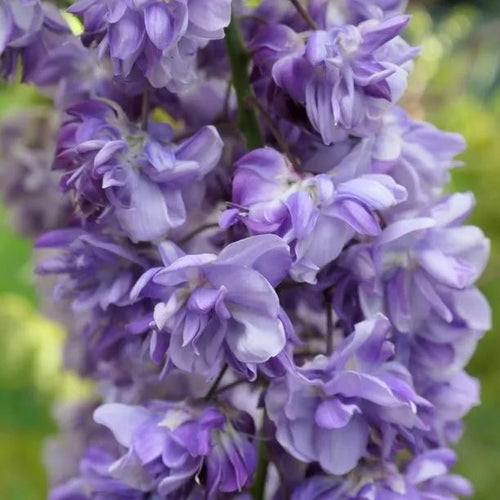Black Dragon / Kokuryu Wisteria
Wisteria Black Dragon (Kokuryu in Japanese) is a wonderful twining climber producing dark purple, cascading, heavily spice scented flowers in May/June. These flowers can reach 2' in length. Its growth is very vigorous and, as it's not self-clinging, will need a strong support.
It's fully hardy but requires a fertile, moist but well-drained soil and prefers sun or dappled shade. It'll need pruning twice a year to encourage flowers; two months after the flowers have finished and, again, in mid-winter. It'll flower quickly, after just one or two years.
Browse our variety of wisteria or our full range of climbing plants.
Garden Design Ideas
Kokuryu is a strongly scented dark purple climbing plant with fabulous clusters of pendant flowers produced in May/June just before the foliage appears. It prefers sun but will thrive in dappled shade and is best planted where the fragrance can be appreciated.
It needs the solid support of a pergola, pillar or a wall with vines eyes and wires set at 12" distances. It can also be grown more formally as a half-standard in a tub with a frame. It can look spectacular grown into mature trees when it'll need very little maintenance save keeping its vigour in check.
Features
- Large deciduous climber
- Long cascading flowers of deep purple
- Delicate spicy perfume
- Fully hardy
- Needs support
- Eventual height and spread of 9m x 5m
- Clockwise twining
- Sun or dappled shade
- RHS Award of Garden Merit
Plant Care
Black Dragon is generally disease free although it can be prone, on occasions, to leaf spot and powdery mildew. Watch for yellowing leaves and honeydew (sticky coating on leaves). If these are seen mealybugs may have infested the plant. Treat with a proprietary control.
All parts of the plant are poisonous and will cause severe stomach problems if ingested. It needs pruning twice a year. Two months after flowering the long shoots should be cut back to 5 or 6 buds from the stem and then, in mid-winter, it should be cut back again to 2 or 3 buds from the stem.
History & Trivia
Black Dragon is now classified as a Wisteria floribunda, Japanese wisteria. Previously, it was classified as a Chinese variety (Wisteria sinensis), and has also been listed as Violacea, Royal Purple, and Russelliana. It was introduced by an English botanist and zoologist named Thomas Nuttall who named it after Dr Caspar Wistar, a famous physician.

 Secure, One-Tap Checkout
Secure, One-Tap Checkout
 Hand Picked, Delivered to Your Door!
Hand Picked, Delivered to Your Door! 1 Year Bareroot Guarantee
1 Year Bareroot Guarantee


